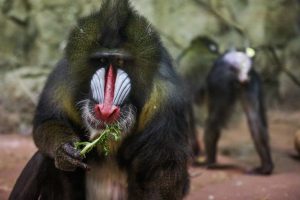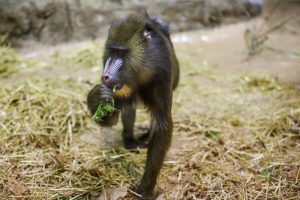Potter Park Zoo keepers Cagney M. and Liz J. attended the Old World Monkey Taxon Advisory Group in August 2017. This meeting, hosted by the Columbus Zoo, was a professional development opportunity for them as they were able to gather information as well as meet others in the zoo community that are passionate about old world monkeys.
 Taxon A
Taxon A
dvisory Groups (TAGs) are composed of expert advisors who help to identify, manage, and support the Association of Zoos and Aquariums (AZA) cooperative animal management programs. They operate at a taxa, not a species, level. The Old World Monkey TAG oversees all African and Asian primates including mandrill, baboon, mangaby, langur and macaques. Each TAG is responsible for identifying goals and essential actions for the animals in their program; managing and recommending taxa for cooperative management between AZA institutions; and providing information pertaining to husbandry, veterinary care, conservation needs and challenges, research priorities, ethical considerations and other issues specific to their taxa.
Many TAG meetings are held yearly and they provide zoo keepers, curators, veterinarians, and other zoo professionals the opportunity to come together and share information applicable to the species in their care. Some of the major topics at the Old World Monkey TAG meeting included training, dealing with aggression, infant rearing, and health and diet related topics. Liz and Cagney attended with the specific purpose of gathering information on mandrill, the only old world monkey species currently housed at Potter Park Zoo.
 Our zookeepers found many of the topics discussed at the TAG important, but took special interest in the discussion on diabetes in primates. About 30% of zoos in the country have at least one diabetic primate. Of those, 51% of the monkeys with diabetes are within the old worldmonkey taxa, and of that, 80% are female. Signs of diabetes in primates are similar to the signs humans exhibit including increased thirst and urination, “sticky” urine due to high levels of sugar passing through the kidneys, weight loss, lethargy, cataracts, and dental disease. And, like humans, some animals are genetically predisposed to getting diabetes.
Our zookeepers found many of the topics discussed at the TAG important, but took special interest in the discussion on diabetes in primates. About 30% of zoos in the country have at least one diabetic primate. Of those, 51% of the monkeys with diabetes are within the old worldmonkey taxa, and of that, 80% are female. Signs of diabetes in primates are similar to the signs humans exhibit including increased thirst and urination, “sticky” urine due to high levels of sugar passing through the kidneys, weight loss, lethargy, cataracts, and dental disease. And, like humans, some animals are genetically predisposed to getting diabetes.
After returning to Potter Park Zoo, Liz and Cagney were able to present the information they had learned to the other zookeepers, curator, and veterinary staff. Due to the age of our mandrill, there was some concern about them, but neither was showing any acute signs of diabetes. However, a few weeks later, zookeeper Annie found what she thought was “sticky” urine in the mandrill exhibit. At this time, the mandrills were put under observation so that a fresh urine sample could be collected. Since Loko, our 25-year-old male mandrill, and Susannah,our 21-year-old female mandrill, were not currently trained for a finger poke, staff had to rely on urine test strips to check their glucose level. After running a urine test on each mandrill, the veterinary staff was able to determine that Susannah had high levels of glucose in her urine and, despite exhibiting no outward signs, was therefore diabetic. Following this diagnosis, their diet was modified to be low in sugar mainly by decreasing amount of fruit fed and the zoo keepers began training Loko and Susannah for blood glucose (sugar) testing.
At Potter Park Zoo, the majority of our animals participate in positive reinforcement training. This type of training rewards the animal for asked for behaviors and their participation is completely voluntary. They can walk away at any time or they can chooseto not train at all. Many of the training goals at the zoo involve training the animals to demonstrate behaviors that assist with husbandry or medical care. These behaviors include presentation of specific body parts, sitting, standing, getting on a scale, opening their mouth, and receiving an injection. Both mandrills have already been trained for injections, but since the zookeepers’ aim is to have Susannah’s blood tested daily, along with the possibility of insulin injections, they focused more intently on modifying this behavior for blood glucose testing. While a urine test can provide some information regarding glucose levels, blood tests provide much more accurate information for management of this disease. Since this kind of training takes time, Susannah was started on oral diabetes medications and urine testing was continued.
To date, Loko has successfully completed the training for a blood glucose test and though he is not diabetic, his blood glucose is monitored weekly so that we know what is normal for him. Despite the keepers continued and dedicated perseverance in training her,  Susannah’s willingness to participate varies, so success with her has been limited. Zookeepers work hard to determine the training rewards she will work for the best and, though it has been challenging, the potential positive welfare benefits are worth the effort.
Susannah’s willingness to participate varies, so success with her has been limited. Zookeepers work hard to determine the training rewards she will work for the best and, though it has been challenging, the potential positive welfare benefits are worth the effort.
The opportunity for Potter Park Zoo keeper staff to attend a variety of professional development sessions is vital to the continued growth of the zoo. The ability to interact with and learn from other animal care professionals has given our staff the tools and resources necessary to care for our animals at the highest level.
Written by Cagney M. & Liz J.



